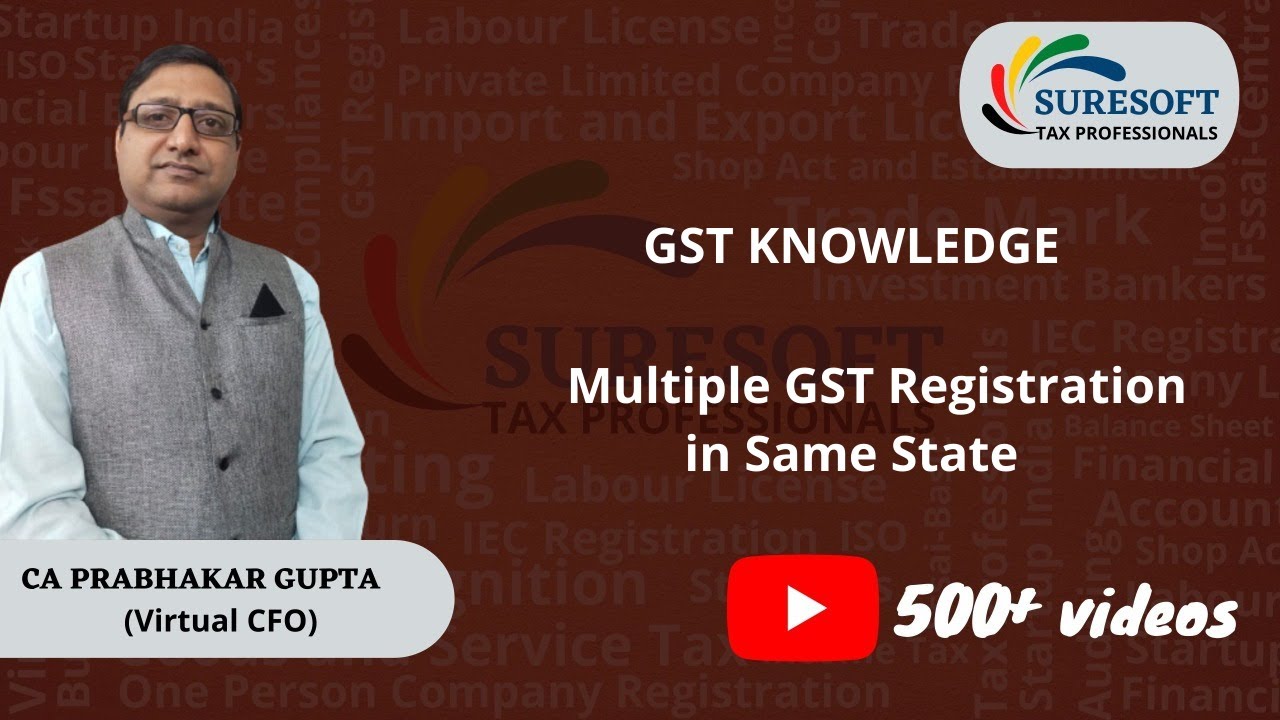Multiple GST Registration in same State
- 14 Aug 24
- 9 mins

Multiple GST Registration in same State
Key Takeaways
- Multiple GST registrations within a single state can significantly improve operational efficiency and tax compliance for businesses with diverse verticals or geographical locations.
- Separate GST registrations for different business verticals allow for better management of input tax credits and provide clarity in financial reporting.
- The criteria for obtaining multiple GSTINs require clear financial and operational independence among the business verticals to prevent any overlap.
- Managing multiple GST registrations increases the administrative burden but also provides a strategic advantage in risk management and compliance isolation.
- It is essential to maintain robust documentation and separate financial accounts for each vertical when applying for multiple GST registrations to meet the stringent verification process by the GST Council.
In India, businesses often face the challenge of managing operations across diverse locations and verticals within the same state. While GST typically mandates a single registration per state, there are exceptions where multiple registrations are not only advantageous but necessary.
Exploring Multiple GST Registrations Within a Single State
The concept of holding multiple GST registrations in a single state is framed by the need to accommodate specific business scenarios that cannot be effectively managed under a single registration. This flexibility is particularly useful for businesses that operate across different geographical areas within the state or that have distinct operational verticals.
Why Consider Multiple Registrations?
Businesses may opt for multiple registrations to enhance operational efficiency, improve tax compliance, and better manage input tax credits. This division helps in localizing business operations in terms of tax collection and liability accounting, providing clarity and precision in financial management.
Legal Framework
According to the GST Act, a business entity can apply for multiple registrations within a single state if it operates multiple business verticals, each with distinct and comprehensive sets of activities. The law requires that these verticals not only be financially independent but also have no overlaps in terms of business operations.
Advantages of Multiple GST Registrations
The primary advantage includes better management of input tax credits as credits earned in one branch can be used to offset the tax liability of the same branch, thus maintaining clear tax trails. Additionally, it allows businesses to provide more focused financial results per division, which can be beneficial for internal performance evaluation.
Potential Challenges
While there are clear benefits, managing multiple GST registrations also comes with its set of challenges. It increases the administrative burden as each registration must independently comply with all GST regulations, including filing returns, maintaining records, and managing taxes. It also multiplies the risk of non-compliance due to the complexity of handling multiple sets of data and regulations.
In summary, while multiple GST registrations in a single state offer significant advantages for certain businesses, they require careful consideration and meticulous management to ensure compliance and to truly benefit from the potential efficiencies.
When to Consider Multiple GST Registrations in the Same State?

Deciding to obtain multiple GST registrations within a single state can be a strategic choice for businesses seeking to optimize their tax responsibilities and administrative efficiency. Here are some specific scenarios where considering multiple GST registrations might be beneficial:
1. Geographical Diversity: For businesses operating in different cities or districts that have distinct compliance demands or local tax benefits, separate registrations can simplify legal and financial management. This approach allows businesses to handle accounting and tax filing adapted to the local tax rules and market conditions.
2. Operational Segregation: If a company runs diverse business operations such as manufacturing and services, or if there are separate divisions for product lines, it may be efficient to manage these verticals under different registrations. This segregation helps in precise tracking of input tax credits and better allocation of resources.
3. Regulatory Requirements: Certain industries might face specific regulatory mandates that require them to maintain separate records and filings for different types of operations. In such cases, having multiple GST registrations can help in maintaining clear and compliant operational trails.
4. Risk Management: Multiple registrations can also be a form of risk management. By segregating business units under different GST numbers, a company can isolate financial and compliance risks within each unit, preventing a compliance issue in one unit from affecting the others.
5. Enhanced Administrative Control: With different GST registrations, businesses can achieve more detailed control over their finances and operations. This setup allows for more accurate benchmarking and performance analysis across different units, facilitating more informed decision-making.
Considering multiple GST registrations is not just about legal compliance, but also about strategic business management. By evaluating the operational, financial, and regulatory dimensions, businesses can decide if this approach will lead to greater efficiency and compliance in their specific circumstances.
Criteria for Multiple GSTIN Registrations
Obtaining multiple GSTINs within the same state involves meeting specific criteria that justify the need for separate registrations under the GST framework. These criteria are designed to ensure that each registered entity can operate independently and that the segregation serves a legitimate business purpose. Here’s a breakdown of these essential criteria:
1. Business Verticals:
- Distinct Operation: Each business vertical for which a separate GSTIN is sought must be involved in distinctively different operations. This means that the products or services offered, the production process, or the business model should not overlap significantly.
- Financial Independence: The financial results of each vertical should be separately ascertainable. This includes having separate profit centers and maintaining independent books of accounts for each vertical.
2. Statutory Compliance:
- Independent Tax Compliance: Each vertical must be capable of independently complying with GST obligations, including the filing of returns, payment of tax, and compliance with other procedural requirements under GST.
- Justification for Separate Registration: Applications for multi-branch GST registration must include a justification as to why separate registrations are necessary.
3. No Revenue Overlap:
- Clear Revenue Streams: There should be no intermingling of revenue between the different verticals. Each vertical should have its own distinct set of customers and vendors, and transactions between the verticals must be at arm's length and fully documented.
4. Physical Separation:
- Separate Locations: Ideally, each business vertical should operate from a separate physical location. If different verticals operate from the same location, there should be a clear demarcation of the premises to prevent any operational overlap.
5. Management Structure:
- Independent Management: Each vertical should ideally have its own management team making independent business decisions without dependency on the other verticals.
Meeting these criteria not only helps in justifying the need for multiple GST registrations but also plays a crucial role in efficient tax administration and compliance. By ensuring that each business vertical can independently handle its tax matters, businesses can minimize complications and enhance transparency in their GST dealings.
Guidelines for Separate GST Registration for Business Verticals

When businesses operate multiple verticals within the same state and consider separate GST registrations for each, it's crucial to adhere to specific guidelines. These guidelines ensure that each vertical is clearly defined and operates independently under the GST framework, which helps in maintaining clear tax responsibilities and compliance. Here’s a detailed look at these important guidelines:
| Category | Guidelines |
|---|---|
| Documentation and Justification | Business Justification: Clearly explain the need for separate registrations by detailing differences in business models, customer bases, or product lines for each vertical. Supporting Documents: Maintain documents such as financial statements, contracts, and employee records to prove the independence of verticals. |
| Operational Independence | Separate Operational Processes: Each vertical should have its own procurement, production, and sales processes. Distinct Physical Location: If operating from the same premises, ensure clear physical demarcation such as different floors or sections for each vertical. |
| Financial Separation | Independent Accounting: Maintain separate books and prepare individual financial statements for each vertical. Separate Bank Accounts: Encourage each vertical to use distinct bank accounts for all financial transactions to uphold financial independence. |
| Management and Staffing | Dedicated Management: Assign independent management teams to handle daily operations and decision-making for each vertical. Independent Staffing: Employ dedicated operational, HR, and accounting teams for each vertical to avoid overlap and ensure unbiased resource allocation. |
| Compliance and Reporting | Individual GST Filings: Each vertical must file its own GST returns independently to accurately report tax liabilities. Audit Trails: Keep detailed audit trails for each vertical including all transaction documents and tax invoices to facilitate compliance during audits. |
This table provides a structured overview to help businesses manage multi-GSTIN registrations for different verticals, ensuring each operates independently and complies with GST regulations effectively.
💡If you want to pay your GST with Credit Card, then download Pice Business Payment App. Pice is the one stop app for all paying all your business expenses.




















